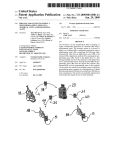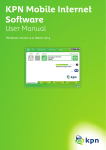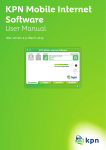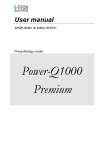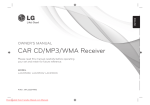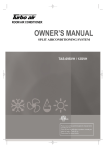Download KPN Mobiel Internet Modem 702
Transcript
KPN Mobiel Internet Modem 702 User manual English Welcome to KPN Mobiel Internet Modem 702 (MIM 702, USB-Modem). MIM 702 provides the following functions: • Accessing the Internet • SMS • Contacts Note: This manual briefly introduces the basic functions of MIM 702. Getting MIM 702 Ready Install Guide 1) Take out the USIM/SIM card slot from MIM 702, and The installation procedures of the MIM 702 Manager then place the USIM/SIM card into the slot, as shown may differ under different operating systems (OS) such in the following figure. Make sure that the USIM/SIM as Windows XP and Windows 2000. Refer to the actual card is fully in place. install tips if there is any difference. 1. Connecting MIM 702 with a PC The sketch map for the data cable is as shown. 1) Insert the Mini-USB connector of the data cable into 2) Insert the slot into MIM 702, as shown in the the MIM 702. following figure. 2) Insert the connector of the main and the auxiliary USB data cable into the USB interface of the PC. 3) The system auto detects and recognizes new hardware and displays on the status area of the desktop, indicating the connection between MIM 702 and the PC is successful. 2. Installing the MIM 702 Mobile Connect Internet Service Manager (Dashboard) 1) Connect MIM 702 to a PC. 1. Network Connection Settings 2) The install program will auto start. If the auto-run To create a new profile: program does not respond, go to the MIM 702 1) Select Settings > Network Connection Settings. movable disk path. Find and double-click the Setup. 2) Click New. exe file, and then the program will auto run. 3) Enter the profile name and the parameters. 3) Install the program according to the prompts on the 4) Click Save. screen. 4) After successful installation, a shortcut icon for Note: For the detailed parameters, consult the local MIM 702 appears on the desktop. network operator. 3. Removing MIM 702 2. Connecting to the Internet To remove MIM 702, use the hardware deleting function 1) Click of the Windows system to stop MIM 702 and then pull it 2) When the connection is created, the current out. to connect to the network. connection information will be displayed on the right 1) Double-click on the status area of the desktop; pane of the window, including connect duration, data the “Safely Remove Hardware” prompt will be volumes, received and sent volumes, rate and the top displayed. rate. 2) Stop the MIM 702 hardware “USB Mass Storage Device”. 3) Click to open the browser. 4) Click to disconnect the network connection. 3) At the prompt, pull MIM 702 out. SMS Introduction to the MIM 702 Dashboard 1. Creating SMS 1) Click to access the SMS window. 1. Accessing the MIM 702 Manager Interface 2) Click Write. Double-click 3) Enter one or more telephone numbers and the SMS on the desktop to start MIM 702 Manager. If the PIN is activated on your SIM, you will be contents. prompted to enter your PIN now. 4) Click Send. 2. Introduction to the Icons Note: While entering telephone number, you can click : Connect/Disconnect the network connection. : Open the default browser of OS. : Access the SMS window. : Access the contacts window. Contacts to search for and add numbers. 2. Viewing SMS 3. Deleting Contacts You can select Settings > Options > SMS Alerts to set the 1) Click prompt methods for a new message. You can select Alert 2) Select one or more contacts and then click Delete. tone or Alert window. 3) At the prompt, click OK. to access the Contacts window. If Alert tone is selected, when there is a new message, you will hear a prompt. 1) Click to access the SMS window. 2) Click Inbox to view the messages. 4. Sending SMS 1) Click to access the Contacts window. 2) Select one or more contacts and then click Send. If Alert window is selected, when there is a new message, 3) In the pop-up window, select the telephone numbers a prompts window will be displayed. you want to send a message to and then select OK. Click View to view the message or click Close to view The program will jump to the window for creating a it later. message. 4) The selected contact numbers will be displayed in the 3. SMS Settings blank column of Contacts. Enter the contents of the Select Settings > SMS Settings for the following settings. message and then click Send. • Reports: to set whether ask for a delivery report. • Use same SMS center for reply: to set the receiver to 5. Searching for a Contact use the same SMS center number for reply. 1) Click Search. • • SMS Bear Domain: to set the bear domain for sending box. messages. • • Select the search range in the Field drop-down Validity: to set the valid period during which • Enter the search conditions in the Value text box. messages can be stored in the SMS center. • Select the matching type, such as “Match Whole Word Only” and/or “Match Case”. SMC number: The MIM 702 will auto read the number preset in the USIM/SIM card. If there is no SMS center 2) Click Search Now to begin searching. number in your USIM/SIM card or you have deleted it 3) Click Stop Search to stop searching. by accident, contact your card provider to get it. Safety Information Contacts Service Please read the safety information carefully to ensure the correct and safe use of your wireless device. 1. Creating a New Contact 1) Click to access the Contacts Window. General Recommendations for Use 2) Click New. Always handle your wireless device with care and keep it 3) Enter name, telephone numbers, email address and in a clean and dust-free place. Do not expose your wire- comments. Then click Save. 2. Modifying Contacts 1) Click less device to open flames or lit tobacco products. • Always keep your wireless device dry. • Do not drop, throw or try to bend your wireless to access the Contacts window. 2) Select a contact to modify and then double-click it or click Edit. 3) After the modification, click Save. device. • Do not paint or scratch your wireless device. • Do not attempt to disassemble your wireless device. Doing so will void warranty. Only authorized personnel are allowed to do so. • • This product requires a minimum distance of 1.5 cm Deactivate near Hearing Devices from the body when in operation. Deactivate your wireless device near hearing devices. Keep your wireless device in normal temperature. People with hearing aids may experience interfering noi- Your wireless device can only operate between -5ºC ses near wireless devices. and +45 ºC. • Use approved accessories only. Do not connect your Recommendations for Children wireless device to any incompatible products. Do NOT allow children to play with your wireless device. They could hurt themselves or others, or could acciden- Obey Laws and Regulations tally damage the wireless device. Your wireless device Do not operate your wireless device where it may be un- contains small parts with sharp edges that may cause an safe to do so or where you are required not to do so. injury or a choking hazard. To deactivate your wireless device, close all applications using the wireless device first and then remove the wire- Deactivate While Driving less device from your PC. Do not use the wireless device while driving. Obey all local laws, regulations, rules, orders, signs and notices while using the wireless device. Signs about the Immunity to Interference use of mobile phones should also be obeyed as referring Your wireless device is immune to interferences caused by to other wireless equipment including wireless devices. audible signals. Deactivate in Explosive Areas Cleaning and Maintenance Deactivate your wireless device where the air is potential- • ly explosive. It is rare, but your PC could generate sparks. Before you clean or maintain the wireless device, close all applications using wireless device and remove your wireless device from your PC. Deactivate in Blasting Areas • Deactivate your wireless device where blasting is in progress. Remote-controlled RF devices are often used at construction sites to set off blasting. Clean your wireless device with a piece of soft antistatic cloth. • If the wireless device or any of its accessories does not work, turn to an authorized service center for help. Deactivate in Aircrafts Deactivate your wireless device before boarding or in any Environmental Protection aircraft. Wireless devices can cause interference in air- Observe the local regulations regarding the disposal of crafts. your packaging materials, old wireless device and its accessories. Please promote their recycling. Deactivate at Hospitals Obey regulations or rules at hospitals. Deactivate your SIM/USIM Cards wireless device near medical equipment. Wireless devices While inserting or removing the SIM card, protect can cause interference to cardiac pacemakers, implanted yourself against electrostatic discharge (ESD). Do not defibrillators or other medical equipment. touch the connector of the SIM card. As a precaution, always make sure that the wireless device is already in your hand before you insert or remove the SIM card. Restart on ESDs Certification Information (SAR) Software will attempt to re-initialize a connection once a THIS DEVICE MEETS THE GOVERNMENT’S REQUIRE- substantial electrostatic discharge causes the device to MENTS FOR EXPOSURE TO RADIO FREQUENCY ELECTRO- reset. If the software is not operational after an ESD, MAGNETIC FIELD. restart the modem software application. Your wireless device is a low-power radio transmitter and receiver. When it is running, it emits low levels of radio Agency/Regulatory Information frequency energy (also known as radio waves or radio The wireless device is approved for use in many regions frequency fields). of the world. In these regions, the device meets all radio Governments around the world have adopted compre- frequency exposure requirements. The following appro- hensive international safety guidelines, developed by vals and notices apply in specific regions as noted. scientific organizations, e.g. ICNIRP (International Commission on Non-Ionizing Radiation Protection) and IEEE CE Approval (European Union) (Institute of Electrical and Electronics Engineers Inc.), The wireless device is approved to be used in the member through periodic and thorough evaluation of scientific states of the EU. declares that the wireless device is in studies. These guidelines establish permitted levels of compliance with the essential requirements and other radio wave exposure for the public. The levels include a relevant provisions of the Radio and Telecommunications safety margin designed to assure the safety of all persons, Terminal Equipment Directive 1999/5/EC (R&TTE regardless of age and health, and to account for any vari- Directive). ations in measurements. Specific Absorption Rate (SAR) is the unit of measurement Radio Frequency Exposure for the amount of radio frequency energy absorbed by To ensure compliance at all times with the R&TTE Direc- the body when using a wireless device. The SAR value is tive* 1999/5/EC, the wireless device can be held in the determined at the highest certified power level in labo- hand but still requires a minimum distance of 1.5 cm from ratory conditions, but the actual SAR level of the wireless the body when in operation. For body-worn use, it must device while operating can be well below the value. This be suitably mounted so that it is at least 1.5 cm away is because the wireless device is designed to use the mini- from the body. Mounting accessories (for example, belt mum power required to reach the network. clips) cannot be made of metal. Do not put the wireless All models of ’s wireless device are designed to meet device in your pocket. radio frequency exposure guidelines such as European Council Recommendation and Federal Communications Commission Notice (United States). * The general public RF exposure limits referenced in the R&TTE Directive are consistent with the published Guidelines of the International Commission on Non-Ionizing Radiation Protection (ICNIRP) 1998. ICNIRP is a formally recognized non-governmental organization in Non-Ionising Radiation Protection for the World Health Organisation (WHO), the International Labour Organisation (ILO) and the European Union (EU). For more information, visit the ICNIRP website at www.icnirp.de. European Council Recommendation: Before a wireless device model is available for sale to the public, it must be tested according to the technical standard-EN 50361 and not exceed the limit established by the European Council Recommendation: 1999/519/EC for safe exposure. The SAR limit adopted by the 1999/519/EC is 2.0 watts/kilogram (W/kg) averaged over ten gram of tissue. The highest SAR value for this device type when tested is 1.56 W/kg. [EN 50361 scope states “This basic standard applies to any electromagnetic field (EM) transmitting devices intended to be used with the radiating part of the equipment in close proximity to the human ear including mobile phones, cordless phones, etc. The frequency range is 300 MHz to 3 GHz. Therefore, the above text does not address primary use of the wireless device product. Federal Communications Commission Notice (United States): Before a wireless device model is available for sale to the public, it must be tested and certified to the FCC that it does not exceed the limit established by the government-adopted requirement for safe exposure. The SAR limit adopted by the USA and Canada is 1.6 watts/kilogram (W/kg) averaged over one gram of tissue. The highest SAR value reported to the FCC and IC for this device type when tested for use is 1.53W/kg. [There is no reference to the specific reference standard or its applicability to the intended use of the product] FCC Statement This device complies with Part 15 of the FCC Rules. Operation is subject to the following two conditions: (1) this device may not cause harmful interference, and (2) this device must accept any interference received, including interference that may cause undesired operation.







